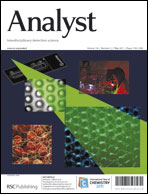A naked-eye selective detection of cyanide ion: studies on the effect of chromophores and spacers on ditopic receptors†
Abstract
A series of novel thiourea based receptors (1–12) with different signaling units and spacers have been synthesized for the detection of


 Please wait while we load your content...
Please wait while we load your content...